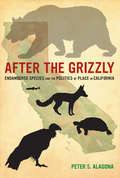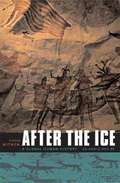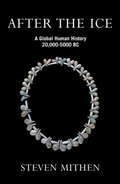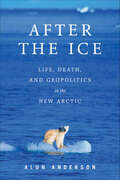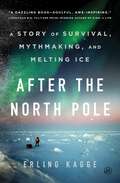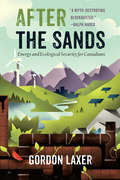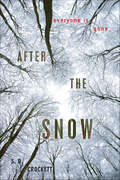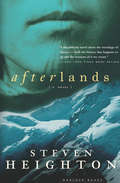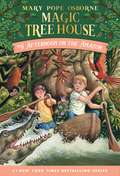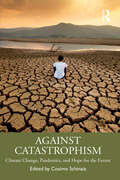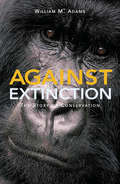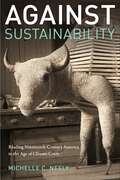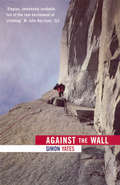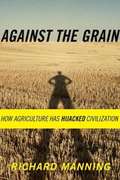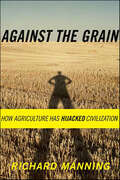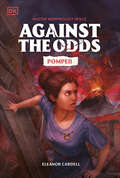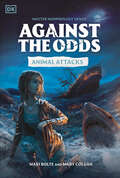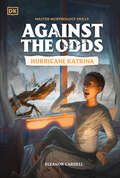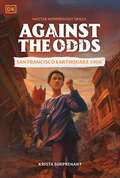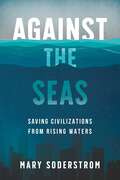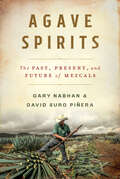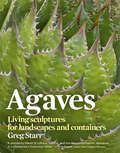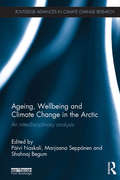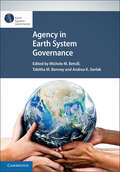- Table View
- List View
After the Grizzly: Endangered Species and the Politics of Place in California
by Peter S. AlagonaThoroughly researched and finely crafted, After the Grizzly traces the history of endangered species and habitat in California, from the time of the Gold Rush to the present. Peter S. Alagona shows how scientists and conservationists came to view the fates of endangered species as inextricable from ecological conditions and human activities in the places where those species lived. Focusing on the stories of four high-profile endangered species--the California condor, desert tortoise, Delta smelt, and San Joaquin kit fox--Alagona offers an absorbing account of how Americans developed a political system capable of producing and sustaining debates in which imperiled species serve as proxies for broader conflicts about the politics of place. The challenge for conservationists in the twenty-first century, this book claims, will be to redefine habitat conservation beyond protected wildlands to build more diverse and sustainable landscapes.
After the Ice: A Global Human History 20,000-5000 BC
by Steven MithenArchaeology says present day humans have been on the planet for eighty thousand years. The first writing has been dated to 3,500 BC. This is what humanity may have been during from 20,000 to 5,000 BC, during the period of global warming which followed the last great ice age. The author uses archaeology to talk about humans at various times during this period of time and at various places on the planet. This book is about what life may have been like day to day over a fifteen thousand year period before we learned to write and live in cities.
After the Ice: A Global Human History, 20,000 - 5000 BC
by Prof Steven MithenA fantastic voyage through 15,000 years of history that laid the foundations for civilisation as we know it by award-winning science writer Steven Mithen.Twenty thousand years ago Earth was in the midst of an ice age. Then global warming arrived, leading to massive floods, the spread of forests and the retreat of the deserts. By 5,000 BC a radically different human world had appeared. In place of hunters and gatherers there were farmers; in place of transient campsites there were towns. The foundations of our modern world had been laid and nothing that came after - the Industrial Revolution, the atomic age, the internet - have ever matched the significance of those events. AFTER THE ICE tells the story of climate change's impact during this momentous period - one that also saw the colonisation of the Americas and mass extinctions of animals throughout the world. Drawing on the latest cutting-edge research in archaeology, cognitive science, palaeontology, geology and the evolutionary sciences, Steven Mithen creates an evocative, original and remarkably complete picture of minds, cultures, lives and landscapes through 15,000 years of history.
After the Ice: A Global Human History, 20,000 - 5000 BC
by Steven MithenA fantastic voyage through 15,000 years of history that laid the foundations for civilisation as we know it by award-winning science writer Steven Mithen.Twenty thousand years ago Earth was in the midst of an ice age. Then global warming arrived, leading to massive floods, the spread of forests and the retreat of the deserts. By 5,000 BC a radically different human world had appeared. In place of hunters and gatherers there were farmers; in place of transient campsites there were towns. The foundations of our modern world had been laid and nothing that came after - the Industrial Revolution, the atomic age, the internet - have ever matched the significance of those events. AFTER THE ICE tells the story of climate change's impact during this momentous period - one that also saw the colonisation of the Americas and mass extinctions of animals throughout the world. Drawing on the latest cutting-edge research in archaeology, cognitive science, palaeontology, geology and the evolutionary sciences, Steven Mithen creates an evocative, original and remarkably complete picture of minds, cultures, lives and landscapes through 15,000 years of history.
After the Ice: Life, Death, and Geopolitics in the New Arctic
by Alun AndersonNew from Smithsonian Books, After the Ice is an eye-opening look at the winners and losers in the high-stakes story of Arctic transformation, from nations to native peoples to animals and the very landscape itself. Author Alun Anderson explores the effects of global warming amid new geopolitical rivalries, combining science, business, politics, and adventure to provide a fascinating narrative portrait of this rapidly changing land of unparalleled global significance.
After the North Pole: A Story of Survival, Mythmaking, and Melting Ice
by Erling KaggeThe Norwegian explorer, philosopher and acclaimed writer tells of his historic 58-day journey to the North Pole on skis in this provocative memoir that is a profound meditation on nature and the history of explorers' obsession. The North Pole looms large in our collective psyche—the ultimate Otherland in a world mapped and traversed. It is the center of our planet’s rotation, one of the places that is most vulnerable in an epoch of global climate change. Its sub-zero temperatures and strange year of one sunset and one sunrise make it an eerie, utterly disorienting place that challenges human endurance and understanding.Erling Kagge and his friend Børge Ousland became the first people “to ever reach the pole without dogs, without depots and without motorized aids,” skiing for 58 days from a drop off point on the ice edge of Canada’s northernmost island.Erling describes his record-making journey, probing the physical challenges and psychological motivations for embarking on such an epic expedition, the history of the territory’s exploration, its place in legend and art, and the thrilling adventures he experienced during the trek. It is another example of what bestselling author Robert MacFarlane has called “Kagge’s extraordinary life in wild places,”Erling also observes the key role that this place holds in our current climate and geopolitical conversations. As majestic, mesmerizing, and monumental as the terrain it captures, After the North Pole is for anyone who has gazed out at the horizon—and wondered what happens if you keep going.After the North Pole is illustrated with 12-14 photographs.Translated from the Norwegian by Kari Dickson.
After the Sands
by Gordon LaxerAfter the Sands outlines a vision and a road map to transitioning Canada to a low-carbon society.Despite its oil abundance, with no strategic reserves, Canada is woefully unprepared for the next global oil supply crisis. There's no good reason for Canadians to use much more oil per capita than people in other sparsely populated, northern countries like Norway, Finland and Sweden-nations that use 27 to 39 percent less oil per person. In After the Sands, Alberta-based political economist Gordon Laxer proposes a bold strategy of deep conservation and a Canada-first perspective to ensure that all Canadians have sufficient energy at affordable prices.The most achievable way to gain energy security is to supply Canadians with their own oil, natural gas and renewable energy. And the best way to cut carbon emissions is by phasing out Canada's role as a carbon-fuel exporter.Canada has all the oil, gas and coal needed to transition to a low-carbon future. Remarkable hydro power resources give Canadians a large base of renewable energy, which can be expanded with wind, solar, geothermal and biomass. Few countries have these options in adequate quantities. But, as Laxer argues, Canada will not get there until we overcome the power of vested interests and untangle the trade agreements that block Canadians from secure and fair access to the nation's own energy resources.Impeccably researched, After the Sands is critical reading for anyone concerned with climate change and the future of Canada.
After the Snow
by S. D. CrockettThe oceans stopped working before Willo was born, so the world of ice and snow is all he's ever known. He lives with his family deep in the wilderness, far from the government's controlling grasp. Willo's survival skills are put to the test when he arrives home one day to find his family gone. It could be the government; it could be scavengers--all Willo knows is he has to find refuge and his family. It is a journey that will take him into the city he's always avoided, with a girl who needs his help more than he knows.S.D. Crockett on narrative voice and an especially cold winter:What was your inspiration for After the Snow?Well, apart from the unbelievably cold winter during which I was writing—in an unheated house, chopping logs and digging my car out of the snow; I think much of the inspiration for the settings in After the Snow came from my various travels. In my twenties I worked as a timber buyer in the Caucasus Mountains of southern Russia, and that work led to travels in Eastern Europe and Armenia. As soon as I step off the plane in those places it smells like home. It may sound strange to say, when After the Snow is set in Wales, but really the practical dilemmas in the book come directly from places I've been, people I've lived with, and the hardships I've seen endured with grace and capability. I was in Russia not long after the Soviet Union collapsed and I've seen society in freefall. Without realizing it at the time I think those experiences led me to dive into After the Snow with real passion.What would western civilization look like with a few tumbles under its belt? What would happen if the things we took for granted disappeared? I wanted to write a gripping story about that scenario, but hardly felt that I was straying into fantasy in the detail.What do you want readers to most remember about After the Snow?We all have the capacity to survive, but in what manner? What do we turn to in those times of trouble? Those are the questions I would like people to contemplate after reading After the Snow.How did Willo's unique voice come to you?Willo's voice appeared in those crucial first few paragraphs. After that it just grew along with his world and the terrible situations that arise. I think his voice is in all of us. We don't understand, we try to make good—maybe we find ourselves.How did you stay warm while writing this novel?I banked up the fire—and was warmed by hopes of spring.
Afterlands: A Novel
by Steven Heighton&“A magnificent novel&” based on the 1872 Polaris expedition that left crewmembers marooned on an ice floe off the coast of Greenland (The New York Times Book Review). It is 1871. Nineteen men, women, and children, hailing from the United States, Germany, Denmark, England, and Sweden, and including two Inuit families, set out on Arctic explorer USS Polaris. But their voyage soon goes wrong. The ship founders, leaving its passengers adrift on an ice floe and, ultimately, stranded alone in the Arctic for six harrowing months. Based on an incredible true story, Afterlands envisions in vivid detail both the life-and-death challenges of the harsh landscape and the violent human threats of nationalism, ethnicity, rivalries, suspicion, hunger, and love. Weaving together fiction and history, and drawing on the writings of one of the passengers on the actual journey, Lt. George Tyson, Steven Heighton&’s &“beautifully written&” novel explores the shattering emotional and psychological consequences faced by those who survived (The Washington Post). &“An exceptionally satisfying adventure.&” —Publishers Weekly
Afternoon on the Amazon (Magic Tree House (R) #6)
by Mary Pope OsborneThe #1 bestselling chapter book series of all time celebrates 25 years with new covers and a new, easy-to-use numbering system! Vampire bats and killer ants? That's what Jack and Annie are about to run into when the Magic Tree House whisks them away to the Amazon River. It's not long before they get hopelessly lost. Will they be able to find their way back to the tree house? Or are Jack and Annie stuck forever in the rain forest? Did you know that there&’s a Magic Tree House book for every kid? Magic Tree House: Adventures with Jack and Annie, perfect for readers who are just beginning chapter books Merlin Missions: More challenging adventures for the experienced reader Super Edition: A longer and more dangerous adventure Fact Trackers: Nonfiction companions to your favorite Magic Tree House adventures Have more fun with Jack and Annie at MagicTreeHouse.com!
Against Catastrophism: Climate Change, Pandemics, and Hope for the Future
by Cosimo SchinaiaAgainst Catastrophism explores catastrophism from multiple vantage points and considers the impact of ongoing crisis on individuals.Bringing together contributors from psychoanalysis, economics, anthropology, and gastroenterology, this book explores themes including fossil fuel culture, social movements like Extinction Rebellion, the COVID-19 pandemic, media messaging, and the future of food supply chains. By assessing the value of a constant barrage of information about catastrophes and considering the need for a containing environment, the chapters explore how we can avoid endorsing a closed-off vision of the future and instead unlock possibilities. The book concludes with a discussion of optimism, radical hope, and how we can put forward a new narrative on nature.Against Catastrophism will be of great interest to psychoanalysts, psychologists, psychiatrists, economists, anthropologists, sociologists, food scientists, environmentalists, ecologists, politicians, and communication experts.
Against Extinction: The Story of Conservation
by William Bill Adams'Conservation in the 21st century needs to be different and this book is a good indicator of why.' Bulletin of British Ecological Society Against Extinction tells the history of wildlife conservation from its roots in the 19th century, through the foundation of the Society for the Preservation of the Wild Fauna of the Empire in London in 1903 to the huge and diverse international movement of the present day. It vividly portrays conservation's legacy of big game hunting, the battles for the establishment of national parks, the global importance of species conservation and debates over the sustainable use of and trade in wildlife. Bill Adams addresses the big questions and ideas that have driven conservation for the last 100 years: How can the diversity of life be maintained as human demands on the Earth expand seemingly without limit? How can preservation be reconciled with human rights and the development needs of the poor? Is conservation something that can be imposed by a knowledgeable elite, or is it something that should emerge naturally from people's free choices? These have never been easy questions, and they are as important in the 21st century as at any time in the past. The author takes us on a lively historical journey in search of the answers.
Against Sustainability: Reading Nineteenth-Century America in the Age of Climate Crisis
by Michelle NeelyAgainst Sustainability responds to the twenty-first-century environmental crisis by unearthing the nineteenth-century U.S. literary, cultural, and scientific contexts that gave rise to sustainability, recycling, and preservation. Through novel pairings of antebellum and contemporary writers including Walt Whitman and Lucille Clifton, George Catlin and Louise Erdrich, and Herman Melville and A. S. Byatt, the book demonstrates that some of our most vaunted strategies to address ecological crisis in fact perpetuate environmental degradation.Yet Michelle C. Neely also reveals that the nineteenth century offers useful and generative environmentalisms, if only we know where and how to find them. Henry David Thoreau and Emily Dickinson experimented with models of joyful, anti-consumerist frugality. Hannah Crafts and Harriet Wilson devised forms of radical pet-keeping that model more just ways of living with others. Ultimately, the book explores forms of utopianism that might more reliably guide mainstream environmental culture toward transformative forms of ecological and social justice. Through new readings of familiar texts, Against Sustainability demonstrates how nineteenth-century U.S. literature can help us rethink our environmental paradigms in order to imagine more just and environmentally sound futures.
Against The Wall
by Simon YatesSimon Yates is 'the one who cut the rope' in Joe Simpson's award-winning account of their epic struggle for survival in Touching the Void. Afterwards, Yates continued mountaineering on the hardest routes. Perhaps the most testing of all was one of the world's largest vertical rockfaces, the 4, 000-ft East Face of the Central Tower of Paine in Chile. Battered by ferocious storms and almost crippled with fear just below the summit, Yates and his three companions are forced into a nightmare retreat. After resting in a nearby town, they return to complete the climb, but Yates knows he still has to face one of life's greatest challenges...
Against the Grain: How Agriculture Has Hijacked Civilization
by Richard ManningIn this bold book, Richard Manning narrates a fascinating revisionist history of agriculture, from the domestication of plants and animals ten thousand years ago to today's corporate megafarms. Instead of a bucolic Ur-myth, Manning portrays an enterprise that was from its inception expansionist, and that did not so much accompany colonialism as drive it. Drawing on the work of anthropologists, biologists, archaeologists, and historians, as well as on his own extensive research, he traces a commodification of grain that has reached its apex in contemporary agribusiness and that has helped to build some of the most familiar -- and dysfunctional -- features of our political and economic landscape.
Against the Grain: How Agriculture Has Hijacked Civilization
by Richard ManningIn this provocative, wide-ranging book, Against the Grain, Richard Manning offers a dramatically revisionist view of recent human evolution, beginning with the vast increase in brain size that set us apart from our primate relatives and brought an accompanying increase in our need for nourishment. For 290,000 years, we managed to meet that need as hunter-gatherers, a state in which Manning believes we were at our most human: at our smartest, strongest, most sensually alive. But our reliance on food made a secure supply deeply attractive, and eventually we embarked upon the agricultural experiment that has been the history of our past 10,000 years.The evolutionary road is littered with failed experiments, however, and Manning suggests that agriculture as we have practiced it runs against both our grain and nature's. Drawing on the work of anthropologists, biologists, archaeologists, and philosophers, along with his own travels, he argues that not only our ecological ills-overpopulation, erosion, pollution-but our social and emotional malaise are rooted in the devil's bargain we made in our not-so-distant past. And he offers personal, achievable ways we might re-contour the path we have taken to resurrect what is most sustainable and sustaining in our own nature and the planet's.
Against the Odds Pompeii (Against the Odds)
by DKThis historical fiction chapter book series features decodable tales of survival against the odds for children aged 10-14Against the Odds: Pompeii is part of the new Against the Odds series, a captivating collection of fiction books inspired by true events. In this instalment, Mount Vesuvius is erupting! Ash is falling like snow and thirteen-year-old Fabia knows something is terribly wrong. Will she escape Pompeii in time to survive this epic disaster?Each title in this collection unravels the extraordinary experiences of young people overcoming incredible challenges. Whether it’s facing the unknown or triumphing against the odds, these stories are both riveting and inspiring.This historical learn-to-read series for children offers:Popular and captivating topics featured in a historical fiction chapter book series. Decodable text in Hi-Lo style that makes the story accessible for striving readers.A focus on prefixes, suffixes, and word roots that enhances decoding, spelling, and vocabulary.Engaging stories that follow historical fiction narratives–inspired by true events–to engage and motivate reluctant readers.The Against the Odds series focuses on morphology, which is largely important for improving spelling and reading comprehension. Pompeii focuses on multiple common noun suffixes. to empower children to become fluent independent readers. Serving as a vital bridge between decodable and mainstream books, this book will empower readers to confidently understand the meaning from text alone.
Against the Odds: Animal Attacks (Against the Odds)
by DKThis historical fiction chapter book series features decodable tales of survival against the odds for children aged 10-14Against the Odds: Animal Attacks is part of the new Against the Odds series, a captivating collection of fiction books inspired by true events. These short stories bring to life some of the world’s deadliest animal attacks, and how three young people beat the odds to survive them.Each title in this collection unravels the extraordinary experiences of young people overcoming incredible challenges. Whether it’s facing the unknown or triumphing against the odds, these stories are both riveting and inspiring.This historical learn-to-read series for children offers:Popular and captivating topics featured in a historical fiction chapter book series. Decodable text in Hi-Lo style that makes the story accessible for striving readers.A focus on prefixes, suffixes, and word roots that enhances decoding, spelling, and vocabulary.Engaging stories that follow historical fiction narratives - inspired by true events - to engage and motivate reluctant readers.The Against the Odds series focuses on morphology, which is largely important for improving spelling and reading comprehension. Animal Attacks focuses on multiple suffixes to empower children to become fluent independent readers.
Against the Odds: Hurricane Katrina
by DKThis historical fiction chapter book series features decodable tales of survival against the odds for children aged 10-14Against the Odds: Hurricane Katrina is part of the new Against the Odds series, a captivating collection of learn-to-read fiction books inspired by true events. In this instalment, Hurricane Katrina hits the city of New Orleans, Jake and his grandma are stranded in their home. How will they escape the rising floodwaters and avoid the chaos and destruction that follows?Each title in this collection unravels the extraordinary experiences of young people overcoming incredible challenges. Whether it’s facing the unknown or triumphing against the odds, these stories are both riveting and inspiring.This learn-to-read series for children offers:Popular and captivating topics featured in a historical fiction chapter book series.Decodable text in Hi-Lo style that makes the story accessible for striving readers.A focus on prefixes, suffixes, and word roots that enhances decoding, spelling, and vocabulary.Engaging stories that follow historical fiction narratives–inspired by true events–to engage and motivate reluctant readers.The Against the Odds series focuses on morphology, which is largely important for improving spelling and reading comprehension. Against the Odds: Hurricane Katrina focuses on \negative prefixes to empower children to become fluent, independent readers. Serving as a vital bridge between decodable and mainstream books, this book will empower readers to confidently understand the meaning from text alone.
Against the Odds: San Francisco Earthquake 1906 (Against the Odds)
by DKThis historical fiction chapter book series features decodable tales of survival against the odds for children aged 10-14Against the Odds: San Francisco Earthquake 1906 is part of the new Against the Odds series, a captivating collection of fiction books inspired by true events. In this installment, fifteen-year-old Chen finds himself in the middle of the deadliest earthquake in US history.Each title in this collection unravels the extraordinary experiences of young people overcoming incredible challenges. Whether it’s facing the unknown or triumphing against the odds, these stories are both riveting and inspiring.This historical learn-to-read series for children offers:Popular and captivating topics featured in a historical fiction chapter book series.Decodable text in Hi-Lo style that makes the story accessible for striving readers.A focus on prefixes, suffixes, and word roots that enhances decoding, spelling, and vocabulary.Engaging stories that follow historical fiction narratives - inspired by true events - to engage and motivate reluctant readers.The Against the Odds series focuses on morphology, which is largely important for improving spelling and reading comprehension. San Francisco Earthquake 1906 focuses on common prefixes and verb suffixes to empower children to become fluent independent readers.
Against the Seas: Saving Civilizations from Rising Waters
by Mary SoderstromAn incredible read.… While unflinching in her analysis, Soderstrom nevertheless gifts us with a message of hope and resilience. — MAUDE BARLOW, activist and author of Still Hopeful: Lessons from a Lifetime of Activism. What can we learn about coping with rising sea levels from ancient times?The scenario we are facing is scary: within a few decades, sea levels around the world may well rise by a metre or more as glaciers and ice caps melt due to climate change. Large parts of our coastal cities will be flooded, the basic outline of our world will be changed, and torrential rains will present their own challenges. But this is not the first time that people have had to cope with threatening waters, because sea levels have been rising for thousands of years, ever since the end of the last Ice Age. Stories told by the Indigenous people in Australia and on the Pacific coast of North America, and those found in the Bible and the Epic of Gilgamesh, as well as Roman and Chinese histories all bear witness to just how traumatic these experiences were. The responses to these challenges varied: people adapted by building dikes, canals, and seawalls; by resorting to prayer or magic; and, very often, by moving out of the way of the rushing waters. Against the Seas explores these stories as well as the various measures being taken today to combat rising waters, focusing on five regions: Indonesia, Shanghai, the Sundarbans of Bangladesh, the Salish Sea, and the estuary of the St. Lawrence River. What happened in the past and what is being tried today may help us in the future and, if nothing else, give us hope that we will survive.
Agave Spirits: The Past, Present, And Future Of Mezcals
by Gary Paul Nabhan David Suro Piñera“A manifesto…[and] a positive spin on the future of mezcal.” —Florence Fabricant, New York Times The agave plant was never destined to become tasteless, cheap tequila. All tequilas are mezcals; all mezcals are made from agaves; and every bottle of mezcal is the remarkable result of collaborations among agave entrepreneurs, botanists, distillers, beverage distributors, bartenders, and more. How these groups come together in this “spirits world” is the subject of this fascinating new book by the acclaimed ethnobotanist Gary Paul Nabhan and the pioneering restauranteur David Suro Piñera. Join them as they delight in the diversity of the distillate agave spirits, as they endeavor to track down the more distant kin in the family of agaves, and as, along the way, they reveal the stunning innovations that have been transforming the industry around tequilas and mezcals in recent decades. The result of the authors’ fieldwork and on-the-ground interviews with mezcaleros in eight Mexican states, Agave Spirits shows how traditional methods of mezcal production are inspiring a new generation of individuals, including women, both in and beyond the industry. And as they reach back into a rich, centuries-long history, Nabhan and Suro Piñera make clear that understanding the story behind a bottle of mezcal, more than any other drink, will not only reveal what lies ahead for the tradition—including its ability to adapt in the face of the climate crisis—but will also enrich the drinking experience for readers. Essential reading for mezcal connoisseurs and amateurs interested in unlocking the past of a delightful distillate, Agave Spirits tells the tale of the most flavorful and memorable spirits humankind has ever sipped and savored. Featuring twelve illustrations by René Alejandro Hernández Tapia and indices that list common and scientific names for agave species, as well as the names of plants, animals, and domesticated agaves used in the production of distillates.
Agaves: Living Sculptures for Landscapes and Containers
by Greg StarrGardeners and garden designers are having a love affair with agaves. It's easy to see why—they're low maintenance, drought-tolerant, and strikingly sculptural, with an astounding range of form and color. Many species are strikingly variegated, and some have contrasting ornamental spines on the edges of their leaves. Fabulous for container gardening or in-the-ground culture, they combine versatility with easy growability. In Agaves, plant expert Greg Starr profiles 75 species, with additional cultivars and hybrids, best suited to gardens and landscapes. Each plant entry includes a detailed description of the plant, along with its cultural requirements, including hardiness, sun exposure, water needs, soil requirements, and methods of propagation. Agaves can change dramatically as they age and this comprehensive guide includes photos showing each species from youth to maturity—a valuable feature unique to this book.
Ageing, Wellbeing and Climate Change in the Arctic: An interdisciplinary analysis (Routledge Advances in Climate Change Research)
by Shahnaj Begum Marjaana Seppänen Paivi NaskaliThe Arctic and its unique natural resources have become objects of increasing concern. Rapid climate change and ageing of the population are transforming the living conditions in the region. This translates into an urgent need for information that will contribute to a better understanding of these issues. Ageing, Wellbeing and Climate Change in the Arctic addresses the important intersection of ageing, wellbeing and climate change in the Arctic region, making a key interdisciplinary contribution to an area of research on which little has been written, and limited sources of information are currently available. The book explores three key areas of discussion. First, various political issues that are currently affecting the Arctic, such as the social categorisation of elderly people. Second, the living conditions of the elderly in relation to Arctic climate change. Third, the wellbeing of elderly people in terms of traditional knowledge and lifestyles. The book also features contributions from a number of key researchers in the field which examine a broad range of case studies, including the impact of climate change on health in Lapland and elderly people and geographical mobility in Norway. This book will be of great interest to scholars of climate change, gerontology and social policy.
Agency in Earth System Governance
by Michele M. Betsill Tabitha M. Benney Andrea K. GerlakThe modern era is facing unprecedented governance challenges in striving to achieve long-term sustainability goals and to limit human impacts on the Earth system. This volume synthesizes a decade of multidisciplinary research into how diverse actors exercise authority in environmental decision making, and their capacity to deliver effective, legitimate and equitable Earth system governance. Actors from the global to the local level are considered, including governments, international organizations and corporations. Chapters cover how state and non-state actors engage with decision-making processes, the relationship between agency and structure, and the variations in governance and agency across different spheres and tiers of society. Providing an overview of the major questions, issues and debates, as well as the theories and methods used in studies of agency in earth system governance, this book provides a valuable resource for graduate students and researchers, as well as practitioners and policy makers working in environmental governance.
